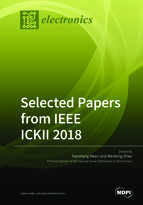Selected Papers from IEEE ICKII 2018
A special issue of Electronics (ISSN 2079-9292). This special issue belongs to the section "Computer Science & Engineering".
Deadline for manuscript submissions: closed (31 March 2019) | Viewed by 30595
Special Issue Editors
Interests: IOT devices; photovoltaic devices; STEM education
Special Issues, Collections and Topics in MDPI journals
Interests: fault-tolerant computing; computer and network security; peer-to-peer and grid computing; performance evaluation of distributed systems
Special Issues, Collections and Topics in MDPI journals
Special Issue Information
Dear Colleagues,
The 1st IEEE International Conference on Knowledge Innovation and Invention 2018 (IEEE ICKII 2018) will be held on Jeju Island, South Korea, 23–27 July, 2018, and it will provide a unified communication platform for researchers on the topics of information technology, innovation design, communication science and engineering, industrial design, creative design, applied mathematics, computer science, electrical and electronic engineering, mechanical and automation engineering, green technology and architecture engineering, material science and other related fields. This Special Issue on “Selected papers from IEEE ICKII 2018” is expected to select excellent papers presented at IEEE ICKII 2018 on the topics of electronics and its applications. Electronic Engineering and Design Innovations are both an academic and practical engineering fields that involve systematic technological materialization through scientific principles and engineering designs. Technological innovation via Electronic Engineering includes electrical circuits and devices, computer science and engineering, communications and information processing, and electrical engineering communications. The main goal of this Special Issue “Selected papers from IEEE ICKII 2018” is to discover new scientific knowledge relevant to followings topics, but are not limited to:
- electrical circuits & devices
- microelectronics and computer technology
- computer science and engineering
- communications & information processing
- electrical engineering communications
- signal processing
- measurements technology
- microwave and electronic system engineering
- microelectronics and optoelectronics
- systems & control engineering
Prof. Dr. Teen-Hang Meen
Prof. Dr. Wenbing Zhao
Guest Editors
Manuscript Submission Information
Manuscripts should be submitted online at www.mdpi.com by registering and logging in to this website. Once you are registered, click here to go to the submission form. Manuscripts can be submitted until the deadline. All submissions that pass pre-check are peer-reviewed. Accepted papers will be published continuously in the journal (as soon as accepted) and will be listed together on the special issue website. Research articles, review articles as well as short communications are invited. For planned papers, a title and short abstract (about 100 words) can be sent to the Editorial Office for announcement on this website.
Submitted manuscripts should not have been published previously, nor be under consideration for publication elsewhere (except conference proceedings papers). All manuscripts are thoroughly refereed through a single-blind peer-review process. A guide for authors and other relevant information for submission of manuscripts is available on the Instructions for Authors page. Electronics is an international peer-reviewed open access semimonthly journal published by MDPI.
Please visit the Instructions for Authors page before submitting a manuscript. The Article Processing Charge (APC) for publication in this open access journal is 2400 CHF (Swiss Francs). Submitted papers should be well formatted and use good English. Authors may use MDPI's English editing service prior to publication or during author revisions.
Keywords
- electrical circuits and devices
- computer science and engineering
- communications and information processing
- electrical engineering communications







